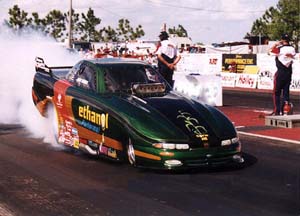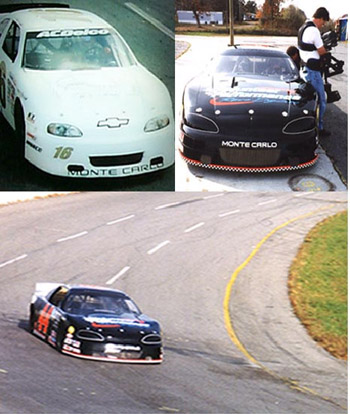Copper Racing to Success
Copper Applications in Automotive
If you were told that the combination of a few parts per million of copper in an oil produced from sunflower seeds was as good as the best formulated mineral engine oils available, you might be sceptical. But it is true. A small, but dynamic research company, Renewable Lubricants Inc (RLI), have produced some remarkable results over the part seven years.
Why copper, and why sunflower seeds? The reasons are relatively simple, although the research work to achieve the current level of performance has been exhaustive and time-consuming.
 Mark Thomas - 4 Time IHRA World Champion Alcohol Funny Car Racer.
Mark Thomas - 4 Time IHRA World Champion Alcohol Funny Car Racer. Sponsored by Corn Growers Association RLI Corn Base Formulas
- SAE 60 Engine Oil
- SAE 75W140 Gear Oil
- SAE 10 Transmission Fluid
The majority of oils and greases for lubricating machinery, and in particular automotive engines, are mineral-based oils derived from petroleum, a source that is non-sustainable, they are very stable and not easy to dispose of.
On the other hand, vegetable oils are produced from renewed sources. Due to their particular chemical composition they are also biodegradable, avoiding problems of disposal. They are non-toxic, and do not create a health hazard if spilt. Safety is also improved, as the vegetable oils possess very high flash points, so that there is reduced fire hazard from the lubricant. Due to their low volatility and high boiling points less lubricant ends up in the exhaust emissions and as particulate material. Viscosity changes with temperature are not so great as with mineral oils, allowing a more fluid oil to be used at room temperature. The better viscosity properties also bring with them less friction and hence reduced fuel consumption. Finally, even though the vegetable oils degrade the solid degradation products adhere to the metallic surfaces and can improve anti-wear properties.
We can conclude therefore that vegetable oils are essentially ecofriendly and readily renewable.
As we now have good reasons for turning to vegetable oils for lubrication, why not use them? There are, unfortunately, as always, problems!
 Robbie White - ASA Champion Stock Car Racer.
Robbie White - ASA Champion Stock Car Racer. RLI Soybean/Canola Base Formulas
SAE 20W50 Racing Motor
Image courtesy of Renewable Lubricants Inc.
Vegetable oils consist of a number of different types of organic molecules. Each type of organic molecule is made up of carbon (C), oxygen (O), and hydrogen (H) atoms. The number of C, O and H atoms, and the way that they are linked together determine both the chemical and physical properties of the molecule. The manner in which the different atoms form a molecule depends on the valence of the atom. Carbon is tetravalent, that is it can form four bonds, oxygen is able to form two bonds, and hydrogen is able to form only one bond. In organic chemistry, lines, as below, represent these bonds:
| - C - - O - H - |It is possible for the C atoms to form double or triple bonds such as
\ / C - C - C = C - / \in which case the molecule is said to be unsaturated (all of the carbon bonds have not been satisfied), conversely, if only single bonds are present at the C atoms, the molecule is said to be saturated (all of the C bonds are satisfied)
The types of molecules present in oils are derived from glycerol, which has the organic formula
H
|
H - C - O - H CH2OH
| |
H - C - O - H or CHOH
| |
H - C - O - H CH2OH
|
H
by replacing the H atoms associated with the O atoms with additional C, O and H atom arrangements, designated R1, R2 and R3,
O
||
CH2OC - R1
| O
| ||
CHOC- R2
| O
| ||
CH2OC - R3
As the oil molecules are derived from glycerol, the new molecules are called triglycerides or triacylglycerols. If R1, R2 and R3 are the same, then the molecule is a simple triacylglycerol, if they are different it is a mixed triacylglycerol.
The properties of the oil depend on the C, H and O atoms in R1, R2 and R3, and how they are arranged. It is possible to determine what R1, R2 and R3 are by a process called hydrolisation, (simply adding water molecules), that converts the R1, R2 and R3 constituents into fatty acids. If hydrolisation is carried out on a typical vegetable oil the fatty acids in Table 1 are produced.
| Name | Molecules per 100 (mol%) | Formula |
|---|---|---|
| Palmitic acid | 18-25 | CH3(CH2)14COOH |
| Oleic acid | 17-38 | CH3(CH2)7CH - CH(CH2)7COOH |
| Linoleic acid | 45-55 | CH3(CH2)4CH - CHCH2CH - CH(CH2)7COOH |
It is important to note that palmitic acid has only single C bonds and is therefore a saturated acid. Oleic acid has a single C double bond and is therefore a monounsaturated acid, and linoleic is a di-unsaturated acid as it has more than one C double bond.
 Neil LaRose - 4 Year World Champion Power Boat Racer.
Neil LaRose - 4 Year World Champion Power Boat Racer. Safety Harbor, FL
RLI Soybean/Sunflower Base Formulas
- Two Cycle Motor Oil
- SAE 75W90 Lower Gear Unit Oil
- ISO Grade Hydraulic Fluid for Steering
RLI determined that for better lubrication properties the maximum amount of R1, R2 and R3 are required that would, on hydrolysis produce monounsaturated acids. In other words R1, R2 and R3 must contain as large a proportion of the oleic constituent as possible. The first objective was therefore to develop crop strains, which would produce more of the monounsaturated component in the oil. This has now been achieved by genetically modifying the crops and already high oleic vegetable oils are available, and in particular a high oleic sunflower oil is now produced which has as much as 80% oleic component. In this way a large step forward has been taken in developing vegetable oils as a renewable source.
Having now developed a means of producing vegetable oils in commercially viable quantities, Sunyl � high oleic sunflower oil is now marketed by SVO Enterprises, Ohio, but it has to be modified to become a useful lubricant, as the sunflower oil still has one practical disadvantage. When used at temperatures up to 250 Celsius it degrades rapidly by effectively joining up the molecules within the oil to produce molecules of higher molecular weight. As the molecular weight increased the melting point increases and eventually solid deposits are formed as sludge. The lubricating properties of the oil are then degraded. These degradation reactions are promoted by oxygen. So the problem is, how to stop oxidation of the oils at engine operating temperatures.
To find out whether an additive is suitable it is necessary to have a relatively quick and economic method of testing. Fired engine testing is prohibitively expensive and time-consuming and so an accelerated oxidation stability micro reactor has been developed by the Chemical Engineering Department Tribology Group of the Pennsylvania State University. This test has a metal block with a small cavity in it into which is placed a small, but measured amount of oil. The oil is heated to the test temperature of 225�C for a set time. The amount of solid deposit, the amount of oil evaporated and the amount of liquid oil still remaining are then determined. The less oil evaporated or converted into a solid deposit, the better the result. A 30-minute test is roughly equivalent to 3000 to 6000 miles use in an automotive engine, depending on engine design and loading of the engine.
Mineral oils also have this problem of oxidation at high operating temperatures and additives have been developed to slow down the oxidation process. These additives have been tried with vegetable oils to establish their effectiveness and have been only partially successful. Tests 2 to 6 in Table 2 shows that the commercially available additives are not wholly satisfactory, even though they reduce degradation compared to sunflower oil without additive, Test 1, Table 1. In fact, after 60 minutes testing all the commercial additives were unsatisfactory.
| Test No | Sample | % Deposit | %Liquid | %Evaporated |
|---|---|---|---|---|
| 1 | Sunflower oil without additive | 52 | 33 | 15 |
| 2 | + 11 vol% mineral oil additive | 6 | 87 | 7 |
| 3 | + 11 vol% service grade additive | 5.5 | 88 | 6.5 |
| 4 | + 1.5 vol% chlorine additive | 8 | 83 | 9 |
| 5 | + 5 vol% of Ketjen lubricant additive | 6 | 88 | 6 |
| 6 | +5 vol% of K-2300 additive | 20 | 70 | 10 |
| 7 | + 2000 ppm copper | 0.5 | 99.5 | 0 |
This is the point at which RLI began to develop alternatives suitable for vegetable oils and turned to soluble copper compounds. They discovered that several types of copper compound could be used including copper dihydrocarbyl thio- or dithio-phosphates, copper dithiocarboamates, copper sulphonates, carboxylates, and phenates. It was important that the additive should be oil soluble for the oxidation inhibition to be effective. By putting amounts from 50 to 3000 part per million (ppm) in the oil a remarkable effect was noted.
Results 7, Table 2, shows that a small amount of oil soluble copper additive, sufficient to give 2000 ppm of copper in the oil, dramatically reduced the degradation of the oil. More significantly, this effect was continued after 30 minutes, and the additive was still effective after 60 minutes testing, by which time the commercial mineral oil additives had all failed.
 New Research Vehicles.
New Research Vehicles. Image courtesy of Renewable Lubricants Inc.
The new vegetable oil lubricant with 2000 ppm copper additive was then tested in a conventional 4-ball wear-testing machine. In this test three steel balls are held stationary and a fourth, top ball is rotated against them whilst submerged in lubricant. Any resulting wear scar is measured. In this test the copper additive increased the wear compared with no additive. even though the results were better than using conventional mineral oil. RLI then discovered that by reducing the copper level to around 500 ppm and adding 500 ppm using a second antimony oil soluble compound, wear was brought down below that seen with sunflower oil alone. Now with only 500 ppm copper and 500 ppm antimony the oil is not only oxidation resistant, but also wear inhibiting.
Conventional scuffing test in which the load on the top ball in a four ball testing machine is increased until lubrication breaks down showed that the new oil formulation allowed the load to be increased from 50 kg untreated sunflower oil to 160 kg for the oil with additives. Commercial SEA 10W30 oil had a scuffing load of less than 80 kg.
A bonus is that the copper and antimony additives used in the new oils are less expensive than additives used for mineral oils.
RLI began back in 1993 on contract for USDA-DOD Advanced materials from Renewable Resources Program, which included collaboration with the Pennsylvania State University. Several vegetable hydraulic and engine oil formulations have been developed. Nervo/Coggin Racing now markets RLI sunflower formula under the label NC-SAE 30 Vegetable Base Racing Oil and use it as the factory fill for their 12,000 rpm engines. RLI have also developed an SAE 60 High Performance Corn Base Racing Oil for the IHRA Mark Thomas Racing Team. In 1994 a 3,000 horsepower, ethanol-fuelled racing car set track records using corn oil lubrication in engine, transmission and differential. RLI are now developing corn base motor oil for a new Flexible Fuel Vehicle FFV E-85 Ford Taurus. More than 45,000 test miles have been accumulated on an Oldsmobile 3.8 liter engine.
The new vegetable oils with copper technology improves the required physical properties of the lubricants to meet the new standards set by industry and/or world governments with a reduction in emissions and increased fuel economy. Copper again shows its versatility in helping provide a solution to a difficult problem.
Innovations wishes to thank William W. Garmier, Vice President of Renewable Lubricants Inc., for providing the information and illustrations contained in this article.
Also in this Issue:
- Transformer Innovations
- Copper Racing to Success
- Transformers Can Contribute to Global Warming Goals
- Copper Patents
